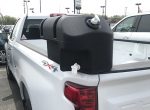In the second part of the series regarding how the commercial transportation industry adapts to the COVID-19 pandemic, we focused on eliminating visual, physical, and cognitive distractions for drivers inside the cab. As we continue to navigate the “new normal,” it’s important we tap technology to ensure maximum safety and efficiency.
Before COVID-19, drivers were used to clogged highways, stopped vehicles, and rush hour traffic around big cities. Now, with many people working from home, there are less commuters and far less vehicles on the road that commercial drivers must deal with during commuter rush hours. But, as states begin to reopen and traffic begins to approach pre-pandemic levels, commercial drivers will need to continue to use caution on emptier streets.
However, it’s important to note that less traffic doesn’t necessarily mean safer roads. For instance, the California Highway Patrol has seen a drastic increase in speeding, and as a result, issued more tickets. In a one-month period when the stay-at-home order started, officers issued 87% more citations to drivers suspected of going more than 100 mph than during the same time period last year. The spike also coincides with a 35% decline in traffic volume on state roads compared to 2019.
LEVERAGE ADAS
Speeding often leads to serious injuries and significantly increases the chance of death in an event of a collision. One way to combat unsafe driving habits is with an Advanced Driver-Assistance System (ADAS). Designed to identify, combat some of the most dangerous driving risks, and intervene with drivers before a collision occurs, ADAS uses a computer vision-enhanced camera to enable real-time driver risk mitigation for following too closely to another vehicle, forward collision, lane departure, and speeding.
With less traffic on the roadways, drivers operating at higher speeds, and increased opportunities for collisions, it’s important to know the following:
- If a driver is at high risk of getting into a collision with other vehicles
- If a vehicle unintentionally drifts from its lane
- If the distance from the vehicle ahead is less than 1.5 seconds, i.e. following too closely
ADAS provides critical in-cab alerts to help drivers avoid collisions. Because of these progressive audio and visual alerts—delivered based on moderate or severe identified risk—drivers receive timely feedback that can lead to self-improvement. Safety managers are able to intervene when necessary, which ultimately leads to a reduction in collisions.
By helping drivers become more aware of their surroundings and driving habits now while there are less drivers on the road, it’s more likely a collision can be avoided once the “new normal” returns—whatever that may look like.
FOR MORE INFORMATION
To gain more insights on communication and coaching, download the eBook, “Coach Your Drivers to Safety and Success,” from SmartDrive. It can help make coaching part of your safety culture, measure your coaching effectiveness, provide advanced analytics for coaching, and more. Find out more, visit www.smartdrive.net.




